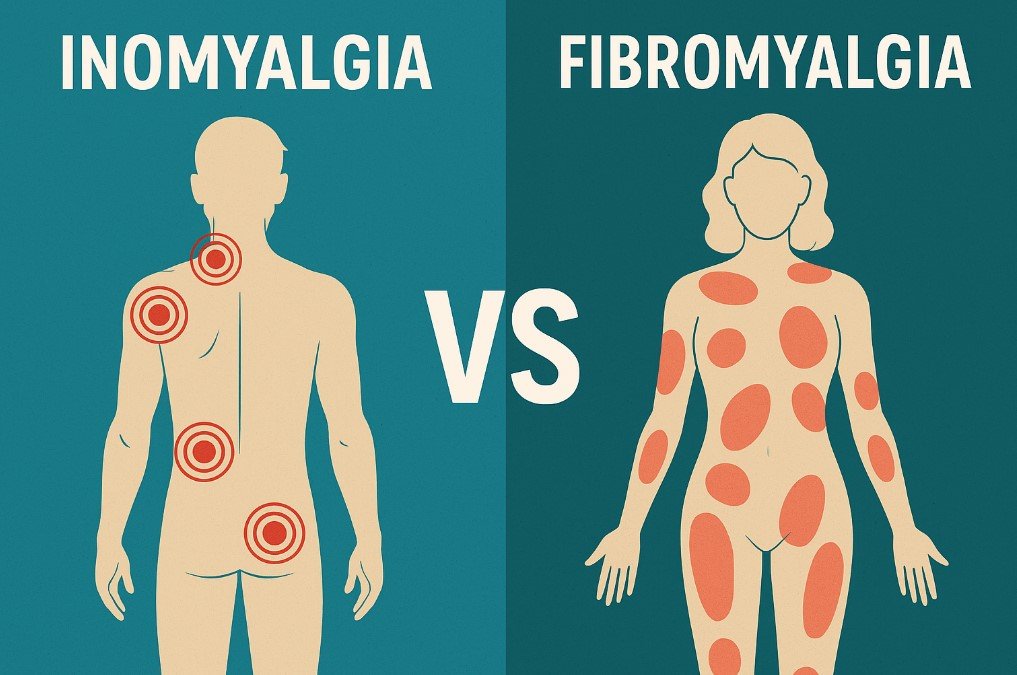Health
Inomyalgia vs Fibromyalgia: Is There a Difference?

Muscle pain is a common complaint that affects people of all ages. Two terms that may come up in this context are inomyalgia and fibromyalgia. While fibromyalgia is a recognized medical condition with specific criteria for diagnosis, the term inomyalgia is less commonly used and not officially listed in medical references like the International Classification of Diseases (ICD). However, it may appear in discussions about muscle pain or in older medical texts.
This article explores the difference between inomyalgia and fibromyalgia, what each term means, and whether they are distinct or overlapping conditions. It also explains the symptoms, causes, diagnosis, and treatment options associated with both.
What is Fibromyalgia?
Fibromyalgia is a chronic disorder known for causing widespread pain in the muscles, ligaments, and tendons. It also leads to fatigue, sleep problems, and cognitive difficulties. Fibromyalgia is recognized by major health organizations such as the World Health Organization and the Centers for Disease Control and Prevention.

People with fibromyalgia often feel constant muscle soreness or aching. They may also experience sensitivity to pressure in specific points of the body. Other symptoms include anxiety, depression, headaches, and difficulty concentrating. This mental fog is sometimes called “fibro fog.”
Doctors believe fibromyalgia is related to how the brain and nervous system process pain signals. The exact cause is still unknown, but it may involve a mix of genetic, environmental, and psychological factors.
What is Inomyalgia?
Inomyalgia is not a widely used medical term. Some sources suggest that it refers to pain in the muscle tissue, similar to myalgia. The prefix “ino-” often relates to muscle or fiber, while “-myalgia” means muscle pain. Therefore, inomyalgia may be used to describe generalized muscle pain in a non-specific way.

Unlike fibromyalgia, inomyalgia is not classified as a medical condition with formal diagnostic criteria. It may be used in limited or historical contexts, or possibly in languages other than English. Because it lacks clinical recognition, it does not appear in modern diagnostic manuals.
In summary, inomyalgia may be a descriptive term for muscle pain, but it is not used to define a disease like fibromyalgia is.
Are they the Same Thing?
No, fibromyalgia and inomyalgia are not the same, although they may seem similar. Fibromyalgia is a medically recognized chronic pain condition with a known set of symptoms and diagnostic criteria. Inomyalgia, on the other hand, is more of a general or outdated term that may be used to describe muscle pain.
Here is a comparison of both terms:
| Feature | Fibromyalgia | Inomyalgia |
| Medical recognition | Official diagnosis | Not formally recognized |
| Common symptoms | Widespread pain, fatigue, sleep issues | Muscle pain |
| Diagnostic criteria | Yes | No established criteria |
| Cause | Unclear but linked to nervous system | Not defined |
| Treatment | Medication, therapy, lifestyle changes | Depends on cause of pain |
| Use in practice | Common | Rare or outdated |
Symptoms Comparison
Fibromyalgia involves many symptoms that go beyond just muscle pain. These include:
- Chronic fatigue
- Widespread muscle tenderness
- Sleep difficulties
- Headaches
- Irritable bowel syndrome
- Anxiety and depression
- Cognitive issues
Inomyalgia, based on its name, would likely only refer to pain in the muscles. There is no evidence that it includes other symptoms such as fatigue, mental fog, or sleep disturbances. Therefore, if a person has multiple symptoms beyond muscle pain, fibromyalgia is more likely to be considered.
How are They Diagnosed?
Fibromyalgia is diagnosed based on a combination of medical history, physical exams, and symptom duration. There is no specific lab test for fibromyalgia. Doctors often rule out other possible conditions before confirming a diagnosis. The American College of Rheumatology has published criteria that help guide this process.
Inomyalgia does not have a set method for diagnosis because it is not a defined medical condition. A doctor might use the term informally to describe muscle pain that is not caused by injury or strain. However, they would still look for the underlying cause, such as an infection, inflammation, or stress.
What Causes Each Condition?
The exact cause of fibromyalgia is unknown. However, researchers believe it may be related to:
- Genetics
- Trauma or physical stress
- Emotional stress or anxiety
- Changes in brain chemicals related to pain
- Sleep disorders
Inomyalgia, being a general term, could have various causes. These might include:
- Overuse of muscles
- Viral infections
- Autoimmune diseases
- Dehydration
- Nutritional deficiencies
- Stress or tension
Because the term is not widely used, the cause of inomyalgia is not well-defined. It may overlap with conditions that also cause muscle pain, including fibromyalgia itself.
Treatment Options
Fibromyalgia treatment often includes a mix of:
- Pain relievers such as acetaminophen or prescription drugs
- Antidepressants to manage sleep and mood
- Anti-seizure medications for nerve pain
- Physical therapy and exercise
- Stress reduction techniques
- Cognitive-behavioral therapy
- Healthy sleep routines
There is no cure for fibromyalgia, but symptoms can be managed with ongoing care.
Inomyalgia treatment would depend on the source of the muscle pain. If it is due to overuse, rest and stretching may help. If it is related to an infection or inflammatory condition, medical treatment will focus on those causes.
Doctors might also recommend:
- Heat or cold therapy
- Massage
- Over-the-counter pain medication
- Hydration and electrolyte balance
- Vitamin or mineral supplements
When to See a Doctor
If you are experiencing ongoing muscle pain, fatigue, or other symptoms, it is important to see a healthcare provider. Early diagnosis and treatment can help improve your quality of life. Fibromyalgia can be managed more effectively when caught early. If the pain is short-term or caused by physical strain, rest and self-care may be enough.
If a doctor uses the word inomyalgia, they may simply be describing general muscle pain without assigning a formal diagnosis. It is always good to ask your doctor for clarification.
Conclusion
Fibromyalgia and inomyalgia may sound similar, but they are very different in meaning and use. Fibromyalgia is a recognized chronic pain condition with specific symptoms and treatments. It affects many people and is managed through a combination of therapies. Inomyalgia, by contrast, is not widely used in modern medicine and may just be a general term for muscle pain.
Understanding the difference is crucial for receiving the correct diagnosis and treatment. If you have muscle pain along with other symptoms like fatigue and poor sleep, fibromyalgia might be a possible cause. However, if your only symptom is muscle pain, other factors like physical stress or nutritional issues may be the reason.
Always speak with a healthcare provider to get a full evaluation and an accurate diagnosis. This will help ensure you receive the right care for your condition.
Also Read: Rash, Itch, Or Disease: How To Differentiate Skin Conditions














